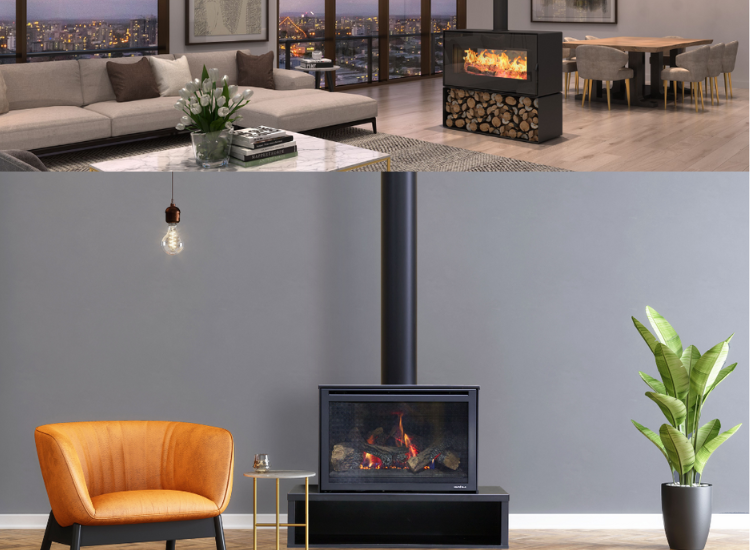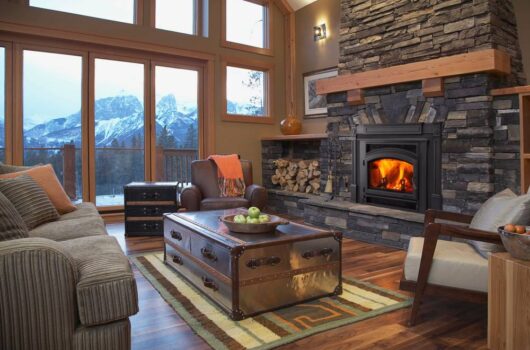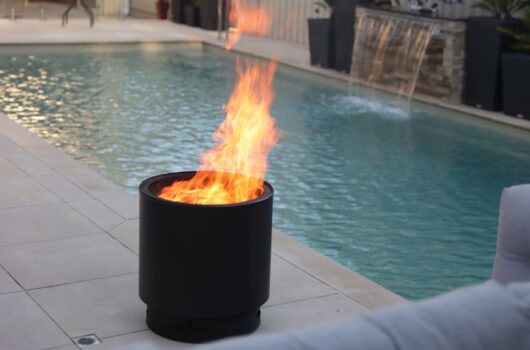-
-
Sales: 1300 219 875
-
Service: 1300 195 482

Having a fireplace can be a real game-changer, especially during those chilly winter months.
But have you ever found yourself wondering which type of fireplace actually puts out more heat? Is a wood fire hotter than a gas flame, or vice versa? It’s a common question with no easy answer – the truth is, there are pros and cons to both options.
In this comprehensive guide, we’ll try to break down the “gas vs. wood” debate. We’ll explore the factors that influence heat output, efficiency, and overall warmth. By the end of this article, you’ll have all the knowledge you need to make an informed decision about which fireplace is the best fit for your home.
Before we can compare the heat output of gas and wood fireplaces, we need to understand kilowatts (kW). This is the standard metric unit of measurement used to quantify the amount of heat generated by a fuel source.
In general, a higher kW rating equals more heat output. However, it’s important to note that kW ratings are based on laboratory conditions and may not accurately reflect real-world performance. Factors like insulation, draught, and fireplace design can all influence how much heat actually gets transferred into your living space.
With that said, let’s take a look at some typical kW ratings for gas and wood fireplaces:
Gas Fireplaces: Small to medium gas fireplaces typically have a rating of around 4 to 7 kW per hour, whereas larger or high-efficiency gas fireplaces can range from 8 to 11 kW per hour or more.
Wood-Burning Fireplaces: Wood fireplaces don’t usually have a straightforward kW rating like gas fireplaces because their output depends on the type and amount of wood burned, as well as the efficiency of the fireplace. However, a well-stocked wood fireplace can produce between 5 to 18 kW per hour, depending on these factors.
As you can see, there is some overlap in the ranges for gas and wood fireplaces, but gas units tend to have a more consistent and quantifiable output. Both types of fireplaces have the potential to produce significant amounts of heat when operating at their full capacity.
While KW ratings give us a baseline for heat output, they don’t tell the whole story. Efficiency is another crucial factor that determines how much of that heat actually ends up warming your living space.
Gas fireplaces tend to be more efficient than wood-burning fireplaces, with efficiency ratings ranging from 60%- 90%. This means that a significant portion of the heat generated by the gas flames is transferred into the room, rather than being lost up the chimney.
Open wood fireplaces, on the other hand, are typically less efficient, with efficiency ratings between 10% and 30%. This is because a lot of the heat produced by the fire gets sucked right up the chimney, along with the smoke and hot gases. Newer wood stoves and inserts can boost efficiency to 60% or higher, meeting the minimum industry requirement for units to be sold in Australia. For instance, our WS-18 unit is 85% efficient, significantly reducing energy wastage compared to traditional open-hearth fireplaces.
So, while a roaring wood fire might produce a similar kW rating to a gas fireplace, much of that heat is lost up the chimney, resulting in less warmth in your living space.
Another factor that contributes to the overall heating experience is how the warmth is distributed throughout the room. Gas fireplaces tend to provide more even, consistent heating, as the flames produce a steady output of warmth that circulates via natural convection.
Wood fires, on the other hand, tend to produce more intense radiant heat. You’ve probably experienced the warmth radiating from the crackling flames of a wood fire. This radiant heat can be incredibly cosy and comforting, but it also means that the areas closest to the fire will be significantly warmer than the rest of the room.
So, while a wood fire might feel hotter when you’re sitting right in front of it, a gas fireplace may actually do a better job of evenly heating the entire space.
If you’re intrigued by the idea of a double-sided fireplace that can warm multiple rooms simultaneously, be sure to check out our in-depth guide on the pros and cons of double-sided fireplaces.
Of course, any discussion about heating options wouldn’t be complete without considering fuel costs and availability. This is another area where gas and wood fireplaces differ significantly.
Natural gas is a readily available fuel source in most areas, and the cost is relatively stable and predictable. While gas prices can fluctuate, they tend to be more consistent than the cost of firewood.
Wood, on the other hand, can be more challenging to source, especially in urban areas. You’ll need to factor in the cost of purchasing firewood (or the time and effort required to source it yourself), as well as the hassle of storage and hauling. Additionally, the quality of the wood significantly impacts the efficiency and performance of your fireplace. Damp or poor-quality firewood will reduce efficiency, whereas gas provides consistent fuel quality, ensuring reliable performance.
Additionally, the cost of firewood can vary significantly depending on your location, the type of wood, and supply and demand factors. In some areas, firewood can be quite affordable, while in others, it can be a significant ongoing expense.
For residents of Victoria, the future availability and pricing of natural gas is an important consideration when choosing a gas fireplace. Our comprehensive article “Fireplaces and the Future of Gas in Victoria” takes a deep dive into the ongoing policy discussions around gas usage in the state.
Another key consideration is the level of maintenance and convenience associated with each type of fireplace. Gas fireplaces are generally considered the more low-maintenance option, as they don’t produce ash or require regular cleaning of the firebox.
Wood fireplaces, on the other hand, require regular cleaning and maintenance to ensure safe and efficient operation. You’ll need to remove ash, clean the firebox, and have the chimney inspected and swept on a regular basis to prevent creosote buildup and potential chimney fires.
Additionally, starting and tending to a wood fire can be a bit of a chore, especially if you’re not an experienced fire-builder. Gas fireplaces offer the convenience of simply flipping a switch or pressing a button to enjoy an instant flame.
In today’s eco-conscious world, it’s also important to consider the environmental impact of your heating choices. Both gas and wood fireplaces have their pros and cons in this regard.
Gas fireplaces are generally considered more environmentally friendly than wood-burning fireplaces, as they produce fewer emissions and particulates. However, natural gas is a non-renewable fossil fuel, so its use does contribute to greenhouse gas emissions.
Wood fireplaces, when burning seasoned hardwood, can be a relatively sustainable and renewable heating option. However, they do produce more particulate matter and emissions, which can contribute to air pollution, especially in densely populated areas.
It’s worth noting that newer wood stoves and inserts are designed to burn more cleanly and efficiently, minimising their environmental impact.
Interested in learning more about the increasingly popular option of electric fireplaces? Check out our beginner’s guide, “How Electric Fireplaces Work“. This article breaks down the technology behind electric fireplaces and their advantages, helping you decide if this eco-friendly alternative is right for your home.
At the end of the day, the decision between a gas or wood fireplace often comes down to personal preference and lifestyle factors. Both options have their advantages and drawbacks, and the “best” choice will depend on your specific needs and priorities.
If you value convenience, low maintenance, and consistent, even heating, a gas fireplace might be the way to go. They’re also a great option for those who live in urban areas or have limited access to firewood.
On the other hand, if you’re drawn to the rustic charm and radiant warmth of a wood fire, a wood-burning fireplace or stove could be the perfect fit. Wood fires also offer a sense of self-sufficiency and connection to nature that some find appealing.
Ultimately, there’s no one-size-fits-all answer to the gas vs. wood debate. It’s about weighing the factors that are most important to you and choosing the option that best aligns with your lifestyle, budget, and personal preferences.
If you’re still feeling unsure about which type of fireplace is right for your home, don’t worry – the experts at Jetmaster Heat & Glo are here to help. With over 40 years of experience in the fireplace industry, we’ve helped countless homeowners navigate the decision-making process.
Our knowledgeable team can guide you through the pros and cons of gas and wood fireplaces, taking into account your specific needs and preferences.
Plus, at Jetmaster Heat & Glo, we offer a wide range of high-quality gas, wood, and electric fireplaces. No matter which type of fireplace you choose, you can rest assured that you’re getting a top-notch product backed by our industry-leading warranty and exceptional customer service.
So don’t wait – upgrade your home with the cosy comfort of a beautiful new fireplace. Call us on 1300 219 875 or get in touch online to get started. Let us help you create the warm, inviting living space you’ve been dreaming of.
Sales:1300 219 875
Services:1300 195 482

Open vs Closed Fireplaces: A Comprehensive Guide for Australian Homeowners

Essential Fireplace Maintenance Tips to Keep It Clean and Efficient

How to Safely Use an Indoor Fireplace in Your Home

Outdoor Wood Fireplaces vs. Gas Fireplaces: Which One Should You Choose?

How do Outdoor Wood Heaters Compare to Other Heating Options